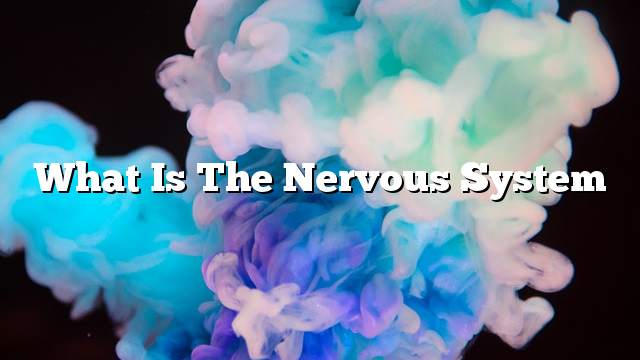Nervous system
Neurons, also known as Nerves, form the nervous system in the human body, and there are billions of nerves in the body. The neuron consists of the cell body and many appendages. Known as Dendrites, which act as sensor horns; they receive signals from nerves and others to move them to the body of the cell, then to the axon, which can reach up to one meter. It is important to note that the nervous system enables the human to communicate with the external environment, in addition to controlling many of the functions of the body and metabolism, and the brain can control the reactions of the body to the pain and touch of hot materials and others, by receiving the sensation, and then treated and sent back through the nerves, Lift the hand on the hot thing immediately after touching it.
Parts of the nervous system
The nervous system can be divided into two parts depending on the location: the central nervous system (Nervous System), which consists of the nerves in the brain (Brain) and spinal cord (Spinal Cord), and lies the central nervous system in the skull and spinal canal , And the second part of the nervous system is the peripheral nervous system (Peripheral Nervous System), which consists of the rest of the nerves of the body.
The nervous system can be divided in a different way depending on the voluntary control as follows:
- Autonomic Nervous System Also known as the Involuntary Nervous System. The function of this device is to control the functions of the body that occur continuously and without conscious demand, such as breathing, heart beat, metabolism. The autonomic nervous system is characterized by rapid response to the conditions and its ability to adapt The body to the surrounding conditions, such as when given a body notice to secrete sweat if the body temperature rises. The autonomic nervous system consists of three main parts, as follows:
- Sympathetic Nervous System, which inhibits digestion and stimulates physical and mental activity. It accelerates the heartbeat and opens the breathing stream to facilitate breathing.
- The Parasympathetic Nervous System (Nervous System), which is responsible for controlling the functions of the body during rest; it helps the body relax, stimulates metabolism and digestion.
- Enteric (gastrointestinal) Nervous System. In fact, this device acts as a separate device; it is limited to control the movement of the intestine during digestion.
- The somatic nervous system (Somatic Nervous System) Also known as the voluntary Nervous System. The function of this device is to control the things we recognize and actions that we are aware of, such as moving arms, legs, and other parts of the body.
Functions of the nervous system
Brain functions
The brain has many functions and can be mentioned depending on the specific part of the brain as it comes:
- Cerebral cortex: This part of the brain controls language, perception, reasoning, thinking, and voluntary movements.
- Cerebellum: This part has the ability to control the body’s posture, balance, and movement.
- Hypothalamus: The hypothalamus is characterized by its ability to control the daily frequency (Circadian rhythm), emotions, body temperature, hunger and thirst.
- Medulla oblongata: The rectum is essential for life; it controls breathing, heartbeat, and blood pressure.
- Thalamus: It integrates sensory information and kinetic information.
- Limbic System: The vascular system works with other parts of the nervous system to control emotional response.
- Base nodes (Basal Ganglia): Basal nodes work to maintain the body’s balance and movement.
- Midbrain: The average brain consists of sites that have the ability to control general body movement, eye movement, hearing, and vision.
Functions of nerves
The function of the nerve varies depending on its type.
- Olfactory Nerve: It is responsible for sniffing.
- Optic Nerve: He is responsible for consideration.
- Oculomotor never (Oculomotor never): This nerve is responsible for the movement of the eye, lens (Lens), and pupil (Pupil).
- Trochlear Nerve: The femoral nerve controls the upper oblique muscle of the eye.
- Abdomens nerve And works to move the eye out.
- Trigeminal nerve: This nerve supports the eyes, cheeks, jaw, and controls the chewing process.
- Facial nerve: This nerve controls Salivary glands, facial muscles, scalp, and ears, as well as a sense of taste from two thirds of the front of the Sun.
- Acoustic Nerve: This nerve is responsible for hearing and maintaining balance.
- The glossopharyngeal nerve Control the taste from the end of the tongue and throat.
- Vagus Nerve: The vagus nerve supports some organs such as the chest and abdomen.
- Additional Nerve: Controls the movement of shoulders and head.
- Hypoglossal Nerve: Controls the movement of the tongue.
Maintaining the health of the nervous system
You can maintain the health of the nervous system and prevent diseases that may be infected by following some tips, including the following:
- Regular exercise.
- Refrain from smoking, alcohol, and drugs.
- Take enough rest.
- Control of diseases such as diabetes and stress.
- Eat a low-fat balanced diet, rich in vegetables, fruits, whole grains, folic acid, vitamin B6, and vitamin B12.
- Eat plenty of water.
- Take care to learn new skills to increase attention span and concentration.
- Reduce the intake of over-the-counter medications.
- Try to avoid strikes and falling.
